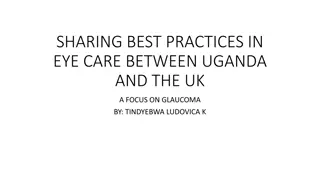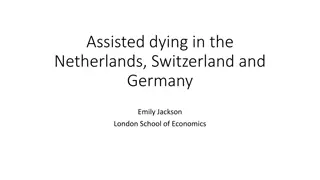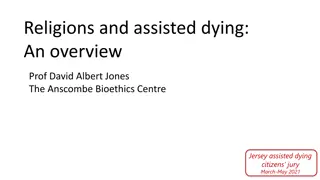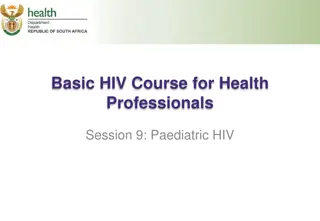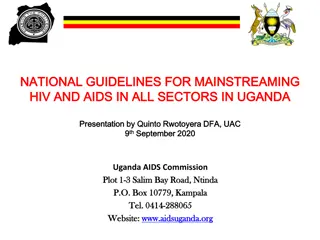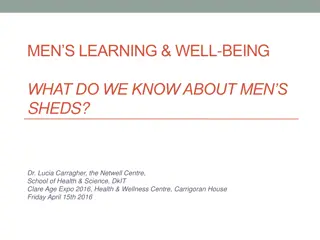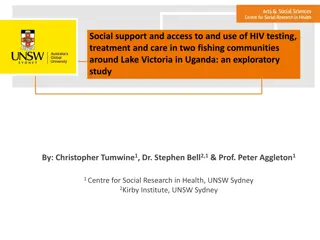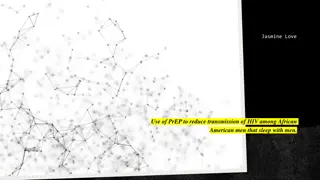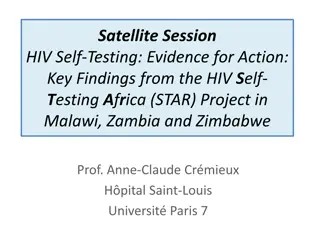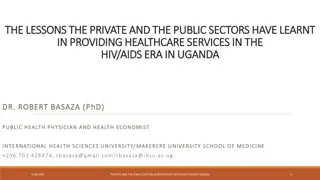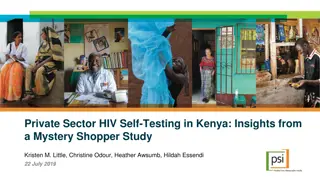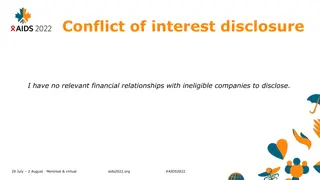Uganda's Successes in Reaching Men with HIV Testing Through Assisted Partner Notification Program
Uganda has successfully implemented an Assisted Partner Notification (APN) program to reach men for HIV testing, addressing the gender gap in testing rates. By utilizing various approaches such as index testing, self-testing, and social network testing, Uganda has achieved significant success in targeting and testing men. The APN approach allows for better targeting, achieving higher yields, and linking individuals to prevention services. The scaling of APN implementation in Uganda includes policy reviews, training of trainers, mentorships, and facility-level setups to manage the testing process effectively. The country aims to reach a substantial number of facilities with APN services by September 2020, showcasing a commitment to scaling up HIV testing among men.
Download Presentation

Please find below an Image/Link to download the presentation.
The content on the website is provided AS IS for your information and personal use only. It may not be sold, licensed, or shared on other websites without obtaining consent from the author. Download presentation by click this link. If you encounter any issues during the download, it is possible that the publisher has removed the file from their server.
E N D
Presentation Transcript
The successes of Ugandas scaled partner notification programme and how it is reaching men Closing the gap on reaching men: Time for action ICASA 2019 satellite John Bosco Matovu (MD) Ministry of Health, Uganda 5 December 2019 www.iasociety.org
Ugandas two main approaches to testing men for HIV 1. Index Testing Assisted partner notification and testing for sexual contacts of all positive index clients Social network testing 2. HIV self testing (HIVST) Secondary distribution through maternal and child health (MCH) services Secondary distribution through key populations Private sector distribution through social marketing www.iasociety.org
Why assisted partner notification (APN)? Uganda s epidemic-driven by heterosexual transmission. Largest 1st95 gap amongst men: Women 75.4%, Men 67.3% APN allows for targeting achieving yields of 25% compared to 3% with general HTS. Linkage to prevention targets vulnerability. Client-centered care: choice of testing in community or at facility. www.iasociety.org
Brief description of APN approach in Uganda HTS focal point at each facility manages index testing process from elicitation. Partner notification choices include: Self-notification (2 weeks to bring in partner or HCW contacts) Assisted notification (HCW reminds to bring in partner after 1 week) Provider notification within 1 week Testing options include facility testing or community testing. www.iasociety.org
Scaling APN implementation in Uganda Policy review (adaptation of WHO guidelines) 2017 Training of national and regional trainers by MOH- 2017 Facility based trainings by MOH & regional trainings in Jan 2018 Mentorships by national and regional technical staff At facility level: APN focal person, APN register, HMIS ACP 021 and monthly reporting DHIS2 captures entire APN cascade (elicited, notified, tested, positive, linked to care) www.iasociety.org
Taking APN to scale Target facility coverage: 2800/3,565 by Sept 2020 July 2018 June 2019: 1,225 facilities offering APN (44% of target) This includes non-PEPFAR supported facilities: 16/734 Completed high volume sites (1,117) now moving to cover low volume sites (108) Scale up with fidelity-routine inquiry www.iasociety.org
APN outcomes for male partners from July 2018-June 2019 100,000 89,103 . 90,000 52% of total contact elicited 2:3 76,942 80,000 84% 64,283 70,000 66% 58,535 60,000 70% 45,224 50,000 40,000 30,000 23% 10,507 97% 10,244 20,000 13% 8,056 10,000 - Female Eligible index clients identified Female Index clients interviewed Male Partners elicited Male Partners notified Male Partners tested Partners tested HIV+ve Partners linked to care Partners already in care www.iasociety.org
Preference for facility versus community testing in rural versus urban facilities FACILITY VS COMMUNITY TESTING OF CONTACTS ELICITED Rural facilities (n=1803) 92% opted for community testing Lower yield overall (37%) and in community (14%) Linkage rates above 95% for both facility and community testing 87% 1831 2000 1800 1600 1400 1200 1000 800 Urban facilities (n=300) Yields high from both facility (80%) and community (54%) testing Linkage rates lower from community testing: Facility testing = 98% Community testing = 87% 600 97% 310 18% 331 98% 154 96% 319 23% 272 400 58% 158 99% 152 200 0 TESTED POSTIVE LINKED INITIATED ON ART FACILITY COMMUNITY Source: Paper register review at 3 urban and 5 rural sites www.iasociety.org
Lessons learnt APN is an ideal strategy to reach men whose identification gap is largest. Ensuring community testing option under the APN platform increases reach to men especially in the rural areas. The yield is higher but the absolute number of HIV positive men identified is lower among men presenting for testing at facilities compared with testing in the community. www.iasociety.org
Challenges APN is a labor intensive and costly intervention to deliver Need to understand cost effectiveness and investment case for Uganda Data systems are mainly paper based with HTS EMR just being introduced Balancing facility and community heath services amidst HRH shortage Scaling up in non-PEFAR sites remains a challenge Need to characterize the nature and extent of adverse events following APN www.iasociety.org
Way forward Integrating APN into routine EPI and ANC outreaches for community testing APN for high risk index negative clients (planned) APN to contribute 40% new positives in FY2019/2020 Use of HIVST to reach more men via the APN platform Leveraging on CHW (VHTs) structures for testing of APN contacts in community? APN cost effectiveness evaluation (planned) Prospective study: nature and extent of AEs following APN www.iasociety.org
THANK YOU Also visit our poster WEPEC205 to view the adolescents and young people APN cascade for Uganda Improving HIV case identification for adolescents and young people through Assisted Partner Notification (APN) approach: Implementation progress in Uganda www.iasociety.org





